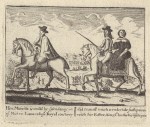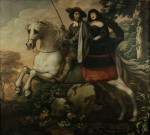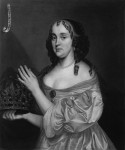- Henry Lascelles, King Charles II, Jane (nee Lane), Lady Fisher by Unknown artist
- King Charles II and Jane Lane riding to Bristol by Isaac Fuller, c. 1660s
by Koren Whipp
Jane Lane, Lady Fisher c. 1613/25[1]–1689 was the daughter of Thomas Lane and Anne Bagot of Staffordshire. She became Lady Fisher on 8 December 1662 when she married Sir Clement Fisher.
Lane played a daring role in the escape of Charles II in 1651. After the Battle of Worcester in 1651 in the English Civil War, Charles II escaped and headed into northern England with several companions, including Lord Henry Wilmot. A reward of £1000 was offered for the capture of the King. There were cavalry patrols tasked with finding the King and anyone aiding him might have been executed for treason. Charles was in hiding at Moseley and was in communication, through Lord Wilmot, with Colonel John Lane who had been an officer in the Royalist Army.[2] Jane Lane, sister to John Lane, had obtained a permit from the military for herself, a servant, and her cousin, Henry Lascelles, to travel to the seaport of Bristol, to visit a relation who was having a baby. It was arranged that the King should take advantage of the military pass and travel to Bristol disguised as Jane Lane’s man-servant, ‘Will Jackson’, and then find a ship to take him to France.[3]
A month later, the Council of State suspected that a woman had helped with the King’s escape. Lane escaped England, walking to Yarmouth in disguise and traveled to France. She arrived in Paris in December 1651 and was welcomed by the Court in exile. Charles II greeted her with the salutation ‘Welcome my life’. The King granted Lane an annual state pension of £1000 and gave her many personal gifts, including a gold watch, portraits of himself and a lock of his hair. And on 19 December 1660 the Convention Parliament bestowed upon her a cash sum of £1000 to purchase a jewel in recognition of her inestimable services to the monarchy.[4]
[1] Her date of birth is unknown, she was probably born sometime between 1613 and 1625, see See J. Sutton, ‘Jane Lane’, ODNB (Oxford: OUP, 2004), vol. 32, pp. 426–7.
[2] James McMullen Rigg, “Lane, Jane,” Dictionary of National Biography, vol. 32 (London: Smith, Elder & Co., 1892).
[3] Rigg, “Lane, Jane,” DNB.
[4] John Sutton, “Mrs. Jane Lane,” Mary Hays, Female Biography; or, Memoirs of Illustrious and Celebrated Women, of All Ages and Countries (1803). Chawton House Library Series: Women’s Memoirs, ed. Gina Luria Walker, Memoirs of Women Writers Part II (Pickering & Chatto: London, 2013), vol. 8, 490-91, editorial notes, 629-31, on 630.
Bibliography
Hays, Mary. “Mrs. Jane Lane.” Female Biography; or, Memoirs of Illustrious and Celebrated Women of all Ages and Countries (6 volumes). London: R. Phillips, 1803, vol. 4, 488-89.
Rigg, James McMullen. “Lane, Jane.” Dictionary of National Biography, vol. 32. London: Smith, Elder & Co., 1892.
Sutton, J. ‘Jane Lane. ’ODNB. Oxford: OUP, 2004, vol. 32, pp. 426–7.
Sutton, John. “Mrs. Jane Lane.” Mary Hays, Female Biography; or, Memoirs of Illustrious and Celebrated Women, of All Ages and Countries (1803). Chawton House Library Series: Women’s Memoirs, ed. Gina Luria Walker, Memoirs of Women Writers Part II. Pickering & Chatto: London, 2013, vol. 8, 490-91, editorial notes, 629-31.
Page citation:
Koren Whipp. “Jane Lane, Lady Fisher.” Project Continua (October 30, 2013): Ver. 1, [date accessed], http://www.projectcontinua.org/jane-lane-lady-fisher/
Tags: Age of Discovery, Baroque, Europe, Spies



